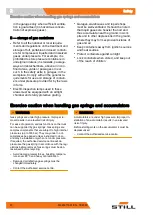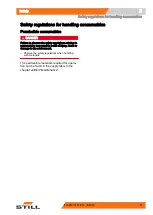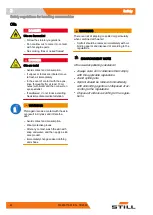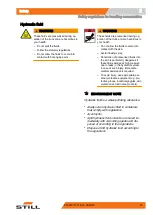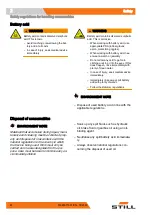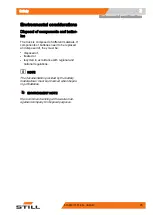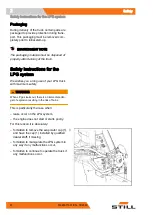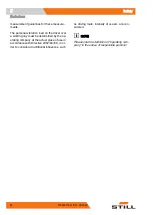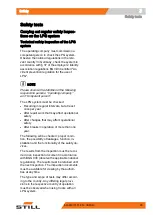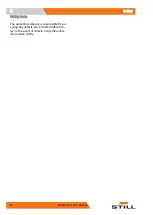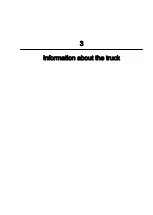
Safety regulations when driving
Driving conduct
The driver must follow the public rules of the
road when driving in company traffic.
The speed must be appropriate to the local
conditions.
For example, the driver must drive slowly
around corners, in tight passageways, when
driving through swing-doors, at blind spots, or
on uneven surfaces.
The driver must always maintain a safe brak-
ing distance from vehicles and persons in
front, and must always have the truck under
control. Stopping suddenly, turning quickly
and overtaking at dangerous or blind spots
must be avoided.
–
Initial driving practice must be carried out in
an empty space or on a clear roadway.
The following are forbidden during driving:
●
Allowing arms and legs to hang outside the
truck
●
Leaning the body over the outer contour of
the truck
●
Climbing out of the truck
●
Moving the driver's seat
●
Adjusting the steering column
●
Releasing the seat belt
●
Disabling the restraint system
●
Raising the load higher than 300 mm above
the ground (with the exception of manoeu-
vring processes during the placement into
stock/removal from stock of loads)
●
Using electronic devices, for example ra-
dios, mobile phones etc.
WARNING
The use of multimedia and communication equip-
ment as well as playing these devices at an exces-
sive volume during travel or when handling loads can
affect the operator's attention. There is a risk of acci-
dent!
–
Do not use devices during travel or when handling
loads.
–
Set the volume so that warning signals can still be
heard.
WARNING
In areas where use of mobile phones is prohibited,
use of a mobile phone or radio telephone is not per-
mitted.
–
Switch off the devices.
Visibility when driving
The driver must look in the drive direction and
have a sufficient view of the driving lane.
Particularly for reverse travel, the driver must
be sure that the driving lane is clear.
When transporting goods that impair visibility,
the driver must drive the truck in reverse.
If this is not possible, a second person acting
as a guide must walk in front of the truck.
In this case the driver must only move at walk-
ing pace and with extra care. The truck must
be stopped immediately if eye contact with the
guide is lost.
Rear-view mirrors are only to be used for ob-
serving the road area behind the truck and not
for reverse travel. If visual aids (mirror, moni-
tor) are necessary to achieve sufficient visibili-
ty, it is necessary to practise using them. For
reverse travel using visual aids, extra care
should be taken.
When using attachments, special conditions
apply; see the chapter entitled "Fitting attach-
ments".
Any glass (variant, e.g. windscreen) and mir-
rors must always be clean and free of ice.
Safety
2
Safety regulations when driving
16
60048011601 EN - 08/2020
Summary of Contents for RCG15
Page 2: ......
Page 4: ......
Page 10: ......
Page 11: ...1 Introduction ...
Page 19: ...2 Safety ...
Page 41: ...3 Information about the truck ...
Page 52: ...Information about the truck 3 Location of the decals 42 60048011601 EN 08 2020 ...
Page 53: ...4 Use and Operation ...
Page 122: ...Use and Operation 4 Decommissioning 112 60048011601 EN 08 2020 ...
Page 123: ...5 Maintenance ...
Page 159: ...6 Technical datasheet ...
Page 160: ...Dimensions Technical datasheet 6 Dimensions 150 60048011601 EN 08 2020 ...
Page 168: ...Technical datasheet 6 Mast specifications 158 60048011601 EN 08 2020 ...
Page 172: ......
Page 173: ......
Page 174: ...STILL GmbH 60048011601 EN 08 2020 ...
Page 176: ......
Page 177: ...7 Diagrams ...
Page 179: ...Hydraulic diagram Diagrams 7 Hydraulic diagram 169 60048011601 EN 08 2020 ...
Page 180: ...Diagrams 7 Hydraulic diagram 170 60048011601 EN 08 2020 ...
Page 181: ......
Page 182: ...STILL GmbH 60048011601 EN 08 2020 ...



















